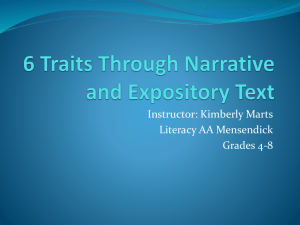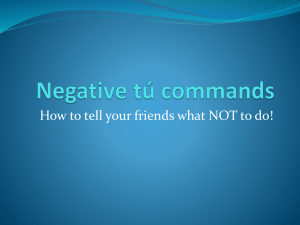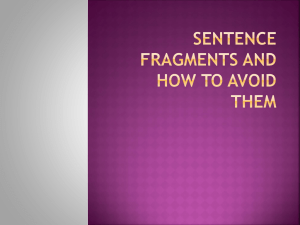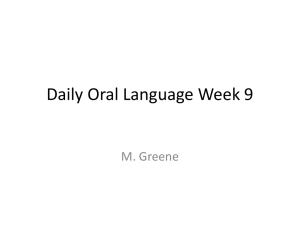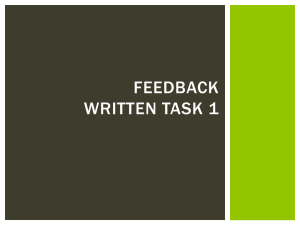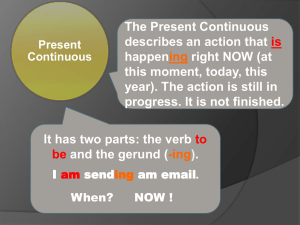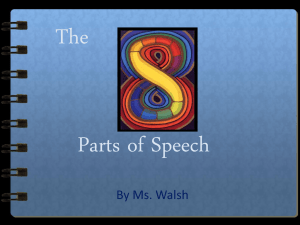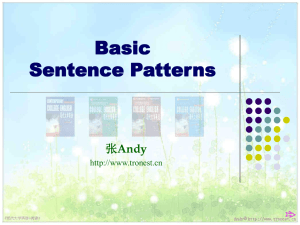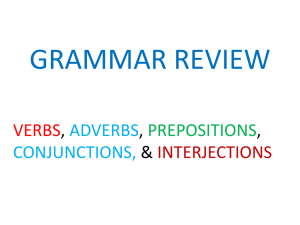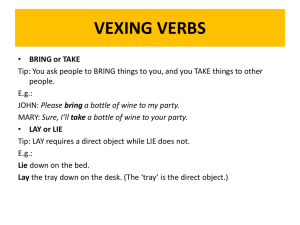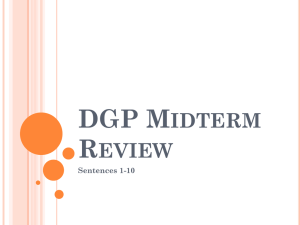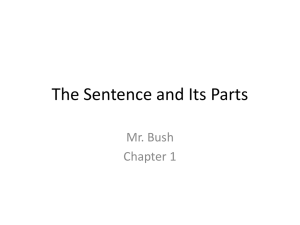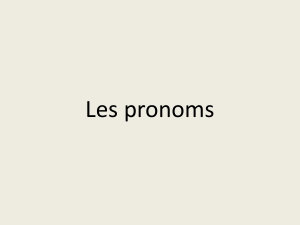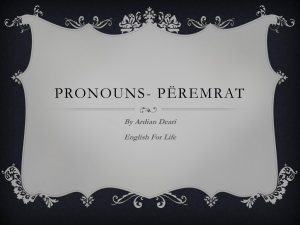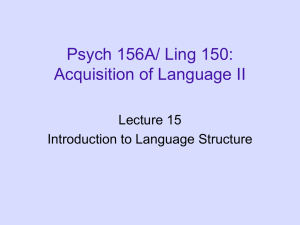Parts of speech
advertisement
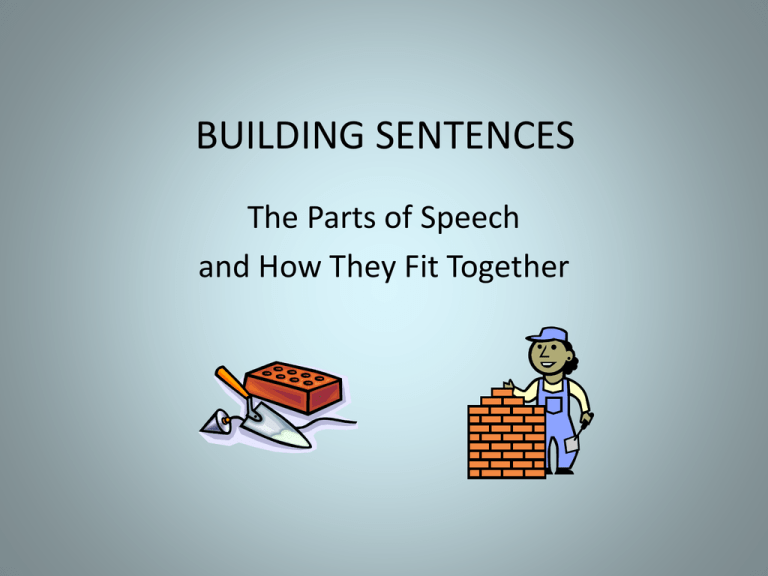
BUILDING SENTENCES The Parts of Speech and How They Fit Together NOUN • A noun names a person, place, thing, or idea – Proper: Mary, Frank, Jose, Medford – Common: car, building, book, money, freedom Identify the nouns in the sentences below. • N N • Example: Rob played his guitar. • Most breakfast cereals contain sugar. • The drawer of the bureau sticks on rainy days. APPLICATION • Label the nouns (N) in the sentences on the handout provided in class. PRONOUN • A pronoun takes the place of a noun. Pronouns eliminate the need for constant repetition. • For example: • The phone rang, and Malik answered the phone. • The phone rang, and Malik answered it. Type: Examples: Personal Indefinite Reflexive Relative Demonstrative Interrogative – I, we, you, me, us, their , it some, everyone, nobody, each, none myself, yourself, ourselves, themselves who, whom, which, that that, this, those, these who, whom, whose, which, what The “pro” in “pronoun” comes from the Latin word meaning “for”. Identify the pronouns in the sentences below. • Pro Pro Pro • Example: He has played it since he was ten. • They all agreed it was a fun party. • Mary wanted to kiss him, but she was too shy. APPLICATION • Label the pronouns (Pro) in the sentences on the handout provided in class. VERB • A verb either shows action or links the subject to another word. Type: Action Linking Examples: run, jump, fish, read, write is, seem, become, feel Every complete sentence must contain a verb. MAIN VERB • Some sentences contain only one verb. It’s the MAIN VERB of the sentence. Examples: (marked with MV) MV The students enrolled in the class. MV The citizens voted. HELPING VERB • Helping verbs show time, condition, or circumstances. These words are ALWAYS helping verbs: can may could will must would shall might should HELPING VERB These words are SOMETIMES helping verbs and SOMETIMES main verbs: have have has had do do does did be am was is were are be being been HELPING VERB Examples of sentences with helping verbs: (marked with HV) HV MV The students have enrolled in the class. HV HV MV The students could have enrolled in the class. HV MV The citizens will be voting. HV HV HV MV The citizens must have been voting. COMPLETE VERB • The complete verb in a sentence includes a MAIN VERB and possibly one or more HELPING VERBS. MV The students enrolled in the class. HV MV The students are enrolling in the class. HV HV MV The students should be enrolling in the class. HV HV HV MV The students must have been enrolling in the class. APPLICATION • Label the helping verbs (HV) and main verbs (MV) in the sentences on the handout provided in class. MODIFIERS • Modifiers limit, describe or intensify a word, or change the meaning in some other way. • ADJECTIVE: Modifies a noun or a pronoun. Example: Ernie is a rich man. The man is rich. • ADVERB: Modifies a verb, adjective, or another adverb. (Usually ends in –ly) Example: The teacher calmly stopped the fight. APPLICATION • Label the adjectives (adj) in the sentences on the handout provided in class. • Label and adverbs (adv) in the sentences on the handout provided in class. CONNECTORS • Connectors show the relationship of one part of a sentence to another. • CONJUNCTION: Joins two parts of a sentence. – Coordinating conjunctions: join two equal ideas. (also called “joining words”) • Example: Kevin and Steve interviewed for the job, but their friend Anne got it. To remember the 7 coordinating conjunctions, remember the word FANBOYS (for, and, nor, but, or, yet, so) APPLICATION • Label the coordinating conjunctions (cconj) in the sentences on the handout provided in class. Conjunctions (continued) • Subordinating conjunctions: When a subordinating conjunction is added to a word group, the words can no longer stand alone as an independent sentence (also known as a “clause”). • Example: • Independent clause: Karen fainted in class. • Dependent clause: When Karen fainted in class • We’ll return to this type of connector after we’ve talked about clauses. CONNECTORS (continued) • PREPOSITION: Relates a noun or pronoun to some other word in the sentence. Prep • She waited by the door. • Prep Prep • One of the yellow lights at the school crossing began flashing. APPLICATION • Label the prepositions (prep) in the sentences on the handout provided in class. Prepositional Phrase [Preposition + possible modifiers + noun or pronoun] Prep object She waited [ by the door]. Prep object Prep object • One [of the yellow lights] [ at the school crossing] began flashing. APPLICATION • Mark the prepositional phrases in the sentences on the handout by putting square brackets [ ] around them. OTHER PARTS OF SPEECH • Interjections – An interjection is a word that can stand independently and is used to express emotion. • Oh, I forgot to tell you something. • Well, isn’t that just terrific? • Articles (sometimes considered adjectives) • a • an • the APPLICATION • Label the articles (art) in the sentences on the handout provided in class. • Look for and label any interjections (int) that you find in the sentences on the handout. Summary of Parts of Speech & Their Abbreviations • • • • • Nouns (N) Pronouns (Pro) Verbs (V) Adjectives (Adj) Adverbs (Adv) • • • • Prepositions (Prep) Conjunctions (Conj) Interjections (Int) Articles (Art) SUBJECTS AND VERBS IN SENTENCES Some things to remember: • Subjects are nouns and pronouns. • To find the subject of a sentence, first find the complete verb of the sentence. • Then ask, “Who or what is doing _______ (whatever the main verb is)? • A sentence may contain more than one subject and more than one verb. APPLICATION • In each sentence on the handout, identify the complete verb by a double underline. • Example: Anna and Rob have gone to the party. • After you have identified the complete verb, as yourself, “Who or what is doing that?” • Find all of the nouns and/or pronouns that answer that question, and underline them with a single underline. Example: Anna and Rob have gone to the party. A NOTE ON VERBALS: • Verbals appear in sentences but do NOT function as verbs. Infinitive: Begins with the word to Examples: to run, to jump, to write MV INF They wanted to enroll. Gerund: The “-ing” form of a verb without a helping verb Examples: running, jumping, writing GERUND MV Running is my favorite form of exercise.

